(If you listen to the voiceover, apologies for my mild croak, I’ve been fending off a cold for a couple of days, which seems to have made the voiceover sound a wee bit different to normal! Sorry! [Plenty of elderberry tincture is keeping it at bay, however!])
Hello, it’s lovely to have you here.
If you have no idea what this message is about, or why you are receiving it, head to this introductory piece, which also contains a chapter listing, with links. Now, without further ado, here’s the fourth week of A Fall In Time.
Introduction: Nature’s Toning
Back in 2010, this was the week I began to move into my shelter, unfinished as it was. I continued to thatch and cover it, and even ventured back into the bright lights of civilisation, a bustling busy metropolitan centre, also known as Fort William (a small town of just over ten thousand people…).
The trees were updating their outfits to match the season and the air was noticeably cooler, especially in the early mornings. I was glad I had made the decision to stay put and live amongst those oaks and deer for a time.
Four weeks of this life in the woods was toning me, physically, yes, but my mind and emotional well-being were also being healed, gently (and, sometimes, not-so-gently) massaged by constant exposure to nature and the rhythms of a wilder place. The air was clean, the water tasted of the glens and mountains through and from which it flowed, and the smoke from the oak I burnt felt purifying. I kept writing, I kept listening, and I kept recording as much of the experience as I could, from dawn to dusk, and beyond.
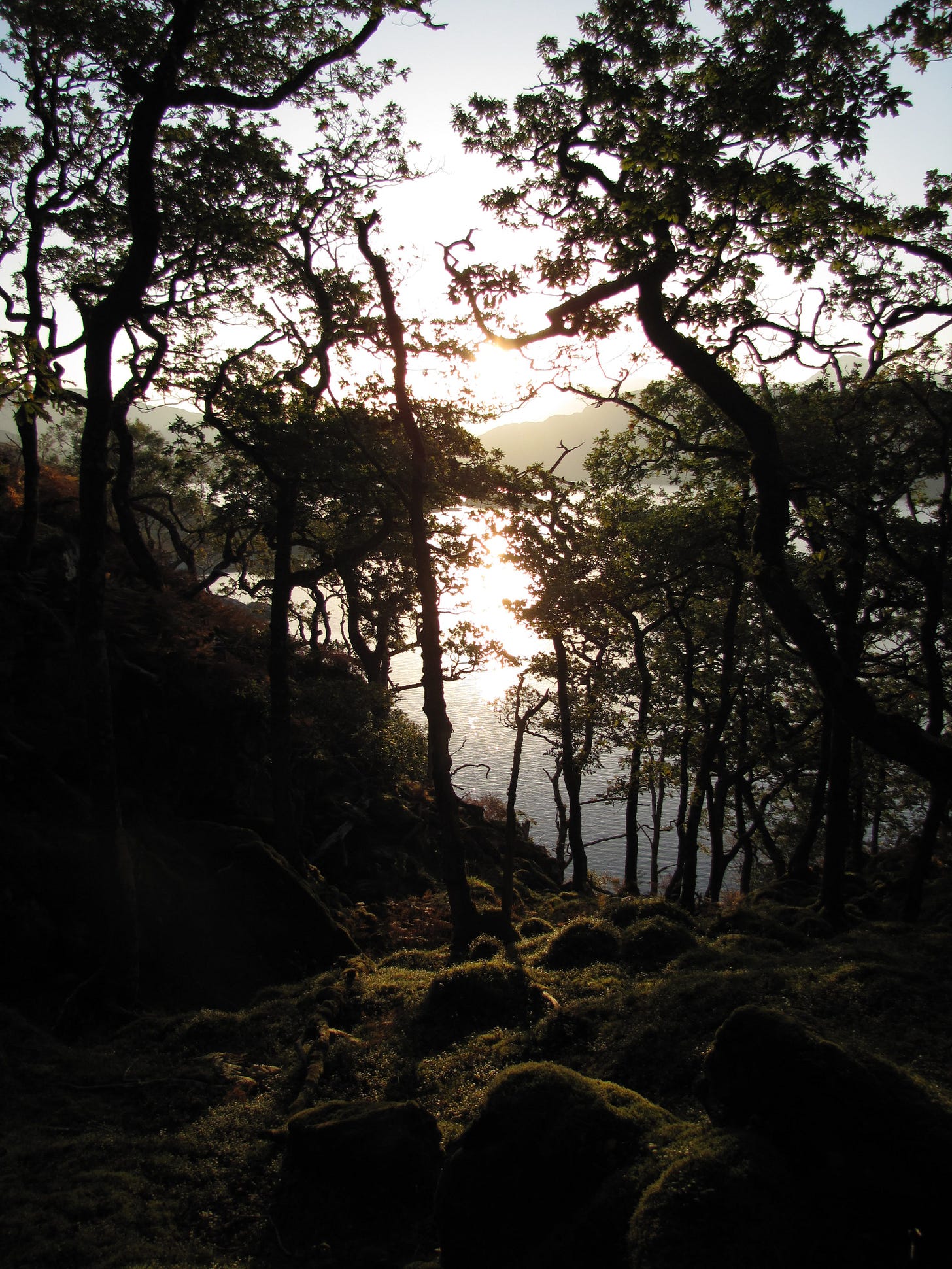
Crashing, and Roaring
The fifth of October, 2010, marked the point where I had now been living out in the woods for three weeks. At the time, I remember thinking of how this was so much longer than was possible using holiday allowance from my work. I also remember thinking how it was almost 50% more time than I had ever spent out in the woods in one go but, as I know now, those three weeks were really just the introduction to that particular adventure.
My journal records that the previous night had been the wildest so far, with a strong gale whipping in from the Atlantic, tearing, cracking, snapping all around me.
When the trees are still in leaf, they suffer more in the wind, each branch acting as mast and sail.
“Sleeping” in a hammock in such weather is always…entertaining. A particularly strong gust is felt through the trees and, at times, the hammock would concertina somewhat, as the trunks themselves flexed. Sitting on the ground in such a storm, it was possible to feel the earth also moving, the mat of shallow roots which held together the shallow cover above the rocks, rippling, bucking, and at times heaving.
I heard crashes and snaps from the trees around me, but it was not until a few days later that I discovered a large branch of oak had fallen precisely at the spot I had been collecting water when I had camped down by the shore. I thought about this a lot at the time—had I been hit by this branch, then it would probably have been game over, it is always essential to look up whenever you set a camp, or even pause for a cup of tea. Any loose, dead branches in the tree can easily slip and fall. That particular branch, however, was living and green, ripped from the oak by the ferocity of the wind. I remember thinking about how I would have at least died happy, doing something I loved, but also worrying about those left behind—and worrying about how they’d actually find me in the first place or whether I’d simply become a part of the soil.
The night before, during the storm, I had also heard crashes of a different nature, followed by the strange roaring of the male red deer. No matter how many times I hear that, it sends a shiver down my spine, somehow feeling ancient, timeless, and right. The rut had started in earnest and the woods were full of testosterone-pumped stags.
On the fifth, I finished the layer of rhododendron branches and made a start on the heather thatching which was to follow. I was lucky with how quickly the branch layer progressed, all those piles of seasoned wood made my job much easier, even if I had to carry it back to camp from all over the hillsides around me. The smaller branches were crucial to the next part of the process, the thatching, as they provided a means to weave the heather in and out, making it a sturdy and intertwined whole. Any bits which poked out would be woven back in as I continued building up the water and wind proofing.
I learnt much about gathering this heather on that day, making mistakes and learning from them. I had never used heather in this manner before, and I initially tried to cut it with my knife, but found it was so tough that the edge was quickly becoming blunt. Rather than keep stopping and reapplying the edge, I moved to my axe, but it proved difficult to swing and cut, and the head would sometimes bounce dangerously. After I nicked the blade of the axe, I stopped and rethought the process. Finally, I discovered it was much easier to use my hands—snapping off where possible, as low down as I could or, failing that, just tearing the heather up. This worked much better, but it was a good job my hands were toughening—heather is sharp and rather prickly.
By weaving the heather from the bottom upwards, both dead plants and live ones, with the top facing down, I could ensure a thick coverage, encouraging water to run downward. I was careful not to collect too much from one area (although Scotland is not lacking in heather!), moving around and making piles which I would then carry back in huge bundles in my poncho.
That evening, I was treated to a rich and spectacular sunset, which turned all golden.
I took rather a number of photos on this day, of the shelter building and of the trees around me. I also counted how many pages of my journal I had filled, not including the blog entries, reaching sixty-nine. Considering I had missed several days during the first week, I was pleased with this. At that point, I did not realise how many hundreds of other pages I would go on to fill, even going back through my notebooks and filling any tiny gaps, linking via a complicated system of page numbers and arrows. Although this infilling makes reading tricky, along with the photographs, those words provide a superb record of this adventure.
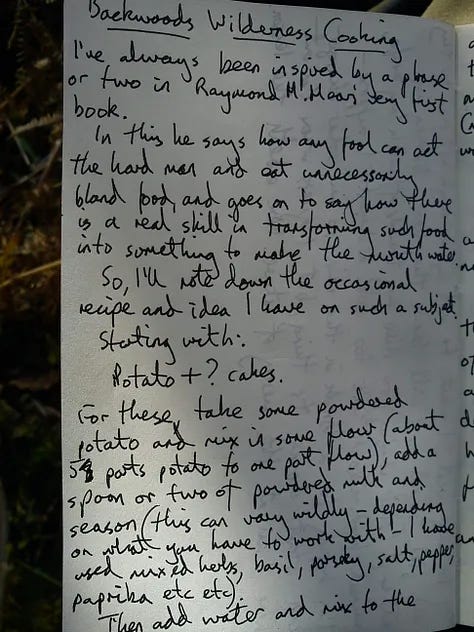
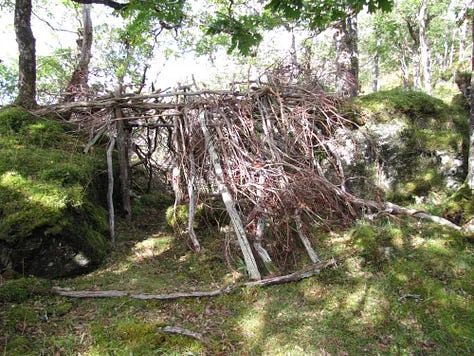
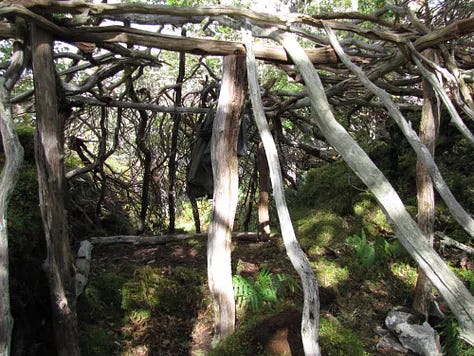
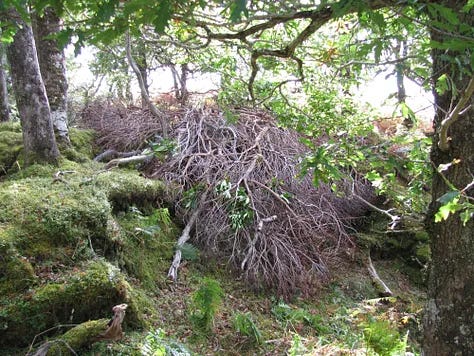
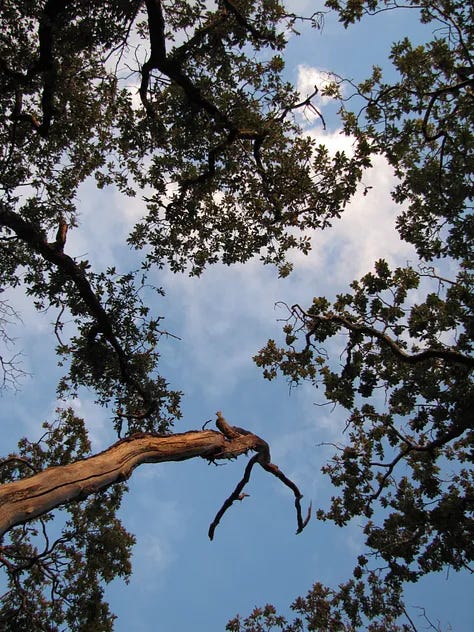
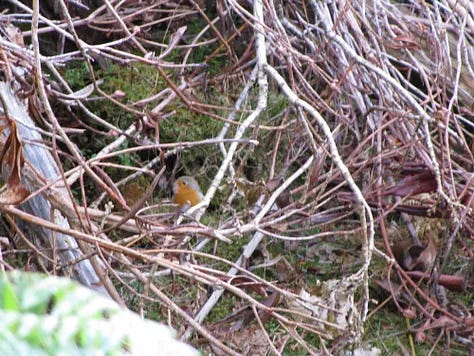
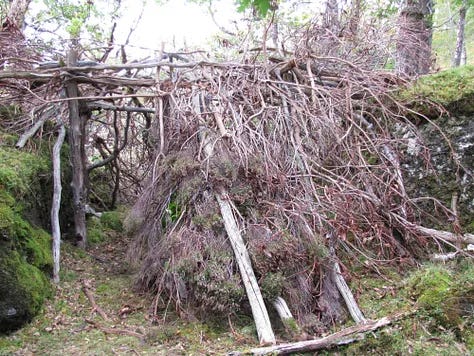
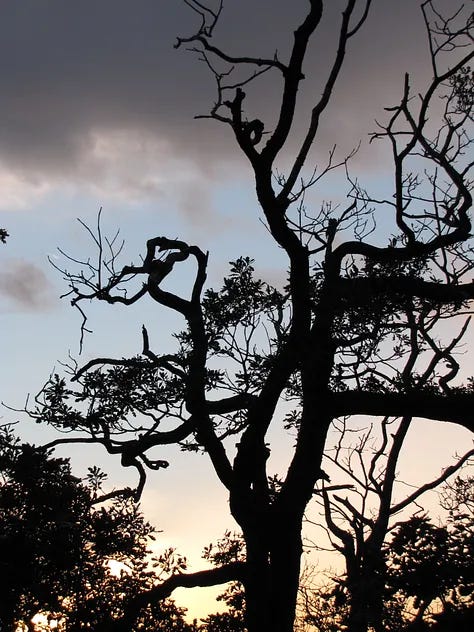
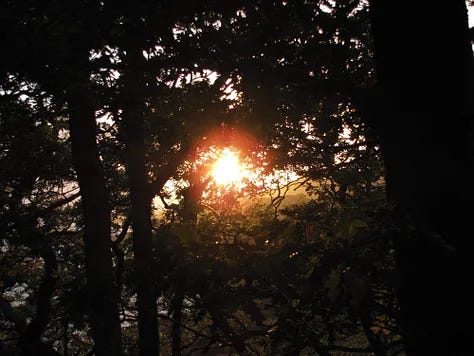
Avian Shelter Cleaners
I have a companion in the form of a robin. He follows me everywhere, sweeping in to gather insects and spiders I disturb. This morning he has already gone over to the shelter—sitting on a log impatiently singing at me to get moving.
Journal One. 6th of October 2010.
I was to gather several avian friends, none of whom seemed scared by my presence, instead using it to further their own needs. Later in this adventure, when it got colder and the sun set, both the robin and a wren would sometimes come inside my shelter to roost in the far corner, utterly undisturbed by me, and delighting in the warmth and protection. Here they were safe from predators, protected from the worst of the weather, with handy snacks of spiders and craneflies on hand.
The robin loved it when I started weaving in the heather thatch. All those insects, whether spider or fly, meant it would spend most of the day following me around, going inside and out of the shelter, hopping from branch to branch, watching me and waiting for newly-disturbed insect life.
As I continued to thatch, I worked out how best to create a frame above the door, moving the heather up and over this, with the intention of adding my poncho to the wooden uprights, thereby adding weatherproofing but, crucially, also creating a chimney effect for the smoke, letting it escape through the hole in the middle, rather than swirl around inside.
By the time this layer of heather was complete the shelter was almost completely windproof. You can also begin to see how well camouflaged the shelter was becoming.
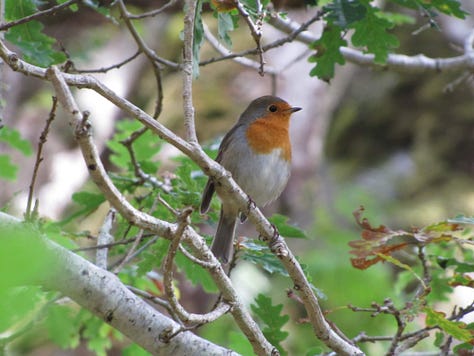
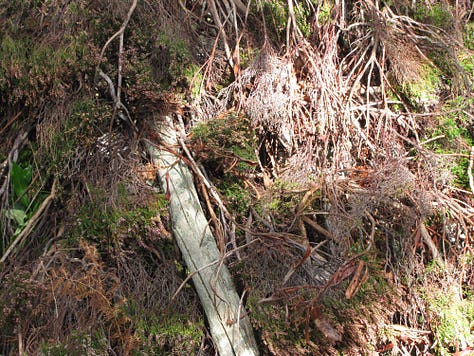
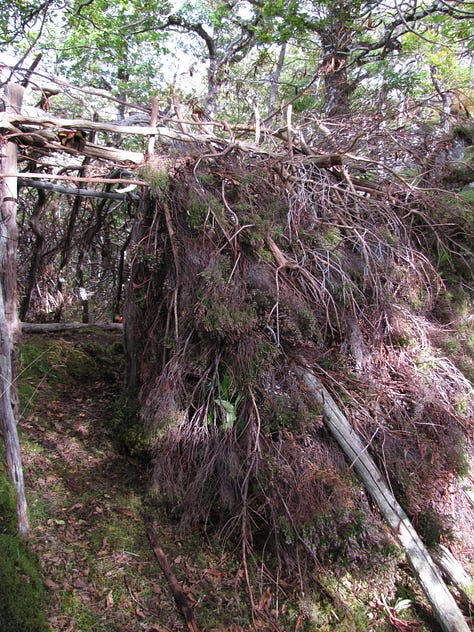
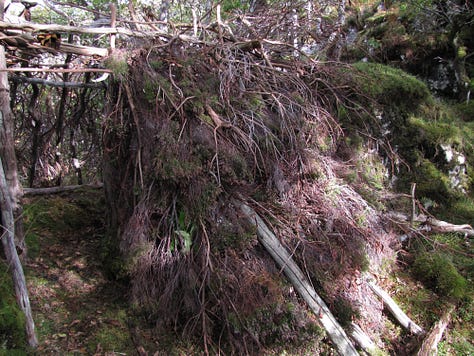
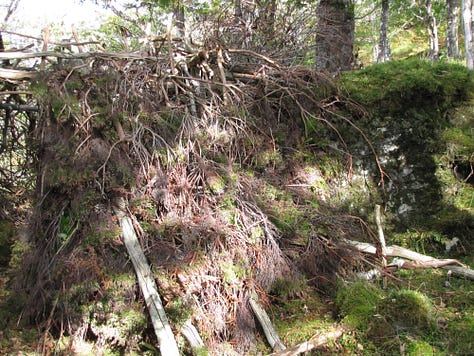
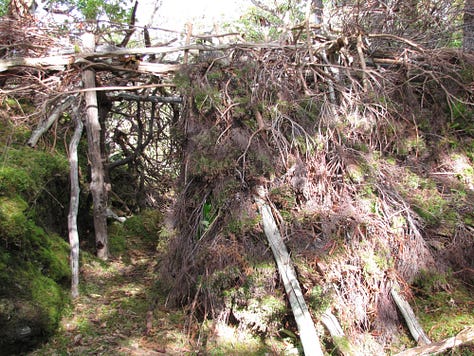

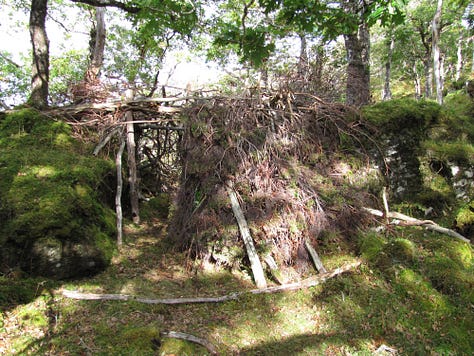
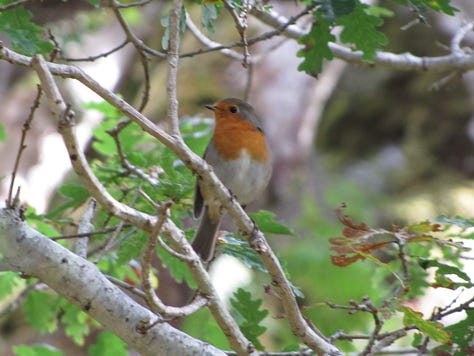
Getting Along With the Neighbours
An owl was hunting close to my camp last night. It screeched in the darkness, as though it wanted to tell me it was there. The deer continue to roar.
Journal One. 7th of October 2010.
At night, the noises in the woods were many and varied. I know some people who are scared of the sounds in the dark, but to me they tell who is close; however, although I have spent hundreds of nights outdoors, there are still sounds that I cannot explain or link to an animal or bird I know.
These voices remain a challenge, to one day be solved with detective work, perhaps checking for tracks in the morning, or ensuring I never underestimate the power of my nose—it is ridiculously poor compared to many animals, but it is entirely possible to scent a deer, or fox or badger when they are close.
On this day, my journal also records that, when I went to the latrine area, then came back to boil water for tea and to roll a cigarette, I noticed a white hair on my trousers, picked up somewhere en route. It was strong, but fine, not as coarse as badger. I was unsure what the species was, but popped it in the small pocket at the back of the Moleskine, where it remains to this day. Looking at it now, I’m relatively sure it is a deer hair, but still not 100%, as there is a darker variation partway along.
However, not all mysteries can be solved—to this day, I am not 100% sure what that particular owl call was, and I’ve spent rather a lot of time listening to various recordings (and found nothing to match the memory).
Twice a day, the little birds would flock to the area of woodland my shelter merged within. They had their rhythms and they had their calls: one for the buzzards overhead, another for the lightning streak of the hunting merlin, scything through the trees, for all the world like a miniature jet fighter.
As I grew to understand their warning cries, I would pause and try and see what had scared them. My senses, heightened though they were, were often simply not strong enough to locate the danger to my feathered friends, but that does not mean I was sure the danger was there. We do not always need to witness a thing to know it is real.
The mixed flock of little birds usually comprised thirty to forty long-tailed tits, blue tits, great tits, coal tits, and the occasional treecreeper. They did their rounds together, each looking out for the next, hunting insects around one tree, then moving to another.
It felt good to have some accepting neighbours as I continued with what my journal records as ‘Operation Chop Lots of Heather’, the ongoing thatching was exhausting, with many scratches and some deeper cuts. Heather is not a forgiving material, but it is a very useful one.
On this day, my journal also notes that I was beginning to consider when to head to Fort William for a bigger resupply (splitting the list into the headings ‘Protein’, ‘Carbs’, ‘Fat’, ‘Other’).
I also discovered, via a text message, that my previous local pub in Sheffield, The Wig and Pen, had gone bust. This felt strangely dislocating, a space I knew well no longer in existence yet, to me, it had already mostly ceased to exist anyway, replaced by oak trees and weathered rock, arrogant and drunken lawyers now bellicose red deer stags. It was odd, how one life could so quickly appear as though it now belonged to a shadow self, a half-forgotten memory, rather than the one I had lived for years. Nature can do that.
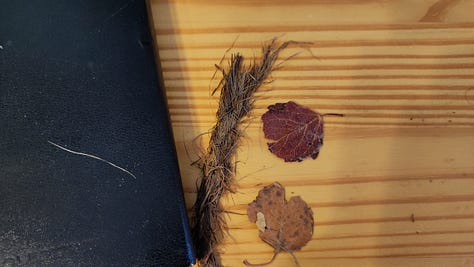
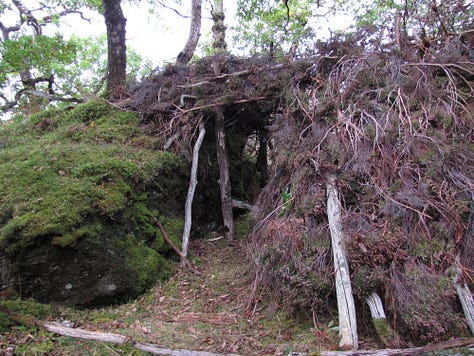
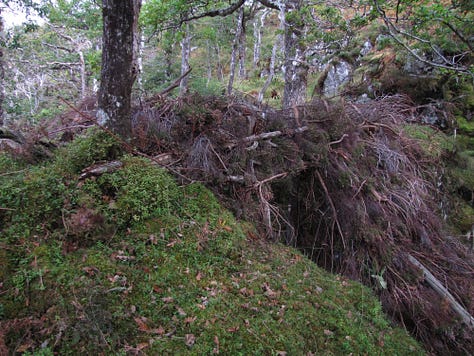
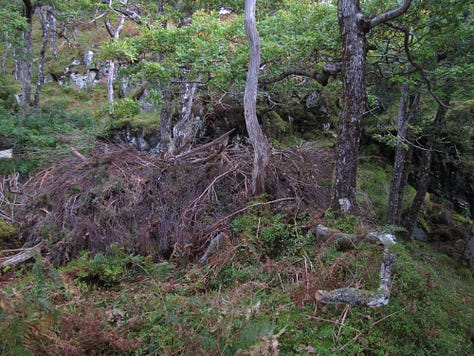
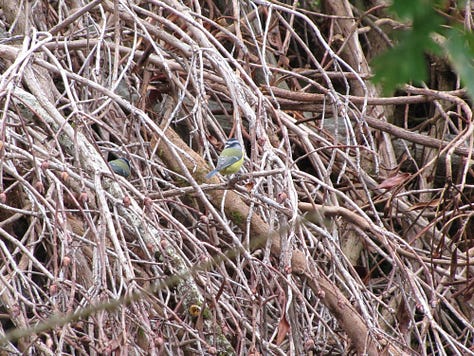
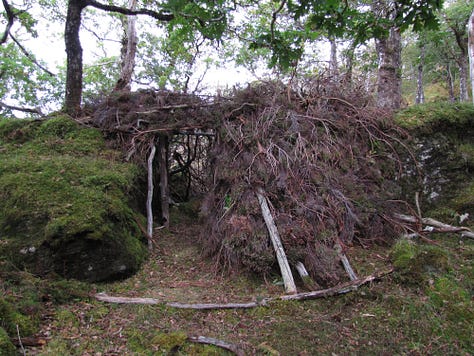
Slow Healing
On the 8th of October, 2010, I took no photos.
In my journal, I crafted a short blog post and also noted that the trees were beginning to lose an increasing amount of their leaves, the strong wind that day leaving deep drifts of them in gullies and against rocks, drifts I had every intention of using in the second to last layer of my shelter.
I continued thatching with heather, along with a trip down to the beach to collect a pack load of driftwood to split for my little stove, nine litres of water, and a pan full of dark, ripe blackberries, to cook for my dessert that evening (my journal records that these desserts became a regular thing from that day, as I found large patches of the berries close to my shelter).
The blog I crafted to send to my sister covered the details of the preceding week: finding the shelter site and beginning construction.
Interestingly, this blog post is framed in a manner which suggested I had not yet made up my mind about whether to stay in the same location all season long, or whether to walk on, northwards.
In my memory—backed up by the notes in my journal—I had made that decision. I am unsure why I framed it differently in that piece, but I suspect I feared judgement from friends I had told of my plan to complete a long walk. This has long been a failing of mine—I have not always shared the entire truth, omitting details in favour of what I think other want to hear*, rather than what I should have perhaps said. This is something I have done considerable work on.
In reality, I was doing exactly what I needed to at that time—I was out in nature, a part of it, walking slowly, sleeping well, thinking deeply.
I was healing.
*I certainly have Rejection Sensitive Dysphoria as a part of the rather curious package of Stuff In My Brain. This probably neatly explains that blog post.
The Uneasiness of Other Humans
It has been a very hot day—I could feel my skin burning at times. Of course, come about 1700, the midges appeared and I hastily split wood and lit the honey stove, grateful for the smoke as I made tea. I cannot wait until I move into the shelter and tend a proper fire.
Journal One. 9th of October 2010.
I have no photos from this date, too busy with completing the heather thatching. Once this layer was finished, I would be able to add my poncho to the door-frame and smoke from the central hearth would draw straight up and out. I had another three layers of cover to go on after this (bracken, leaves/forest floor debris/moss sheets), but I was keen to move in as soon as I could. The shelter did not need to keep rain off me, as I could easily rig my tarp within it if needed, and the heather would prove to be effective at retaining heat from the fire and keeping almost all of the wind from the interior.
My journal records my preparations for a planned upcoming day trip back into civilisation, in order to complete a major resupply. I had made the decision to travel to the town of Fort William, a journey that would involve a hike to the nearest train station and then one of the most beautiful train rides anywhere in the world.
With the nights getting longer and longer and the clocks due to change at the end of the month of October, I knew time was of the essence. I had no intentions of starving myself and Fort William offered more choice for less money. Whilst there, I could also buy some new dry bags, to replace the ones the mice had chewed through, and perhaps a few other useful items.
Despite this, and the promise of a fully-stocked wilderness kitchen (more tea bags! Coffee! Oats! Rice! Peanut butter! Chorizo! Rolling tobacco! [An ever-lengthening list!]), I was glad I had made this decision with plenty of time to mentally prepare myself; the idea of seeing and talking to other people felt alien, uncomfortable, and oddly unnatural.
I moved at the rhythm of nature, not the staccato and somehow fake beat of a railway timetable, but a slower, more fluid, music.
The red deer, however, were upping their own tempo, roaring and crashing together, fight after fight after fight; they woke me at 0230 with the intensity of their roaring and clattering.
When I went to collect heather for thatching and blackberries for eating, I startled a deer, who had been dozing in the hot sun, the night’s exertions and drama obviously requiring a siesta. My journal records that I yet again forgot to take my camera, but the memory is strong, still.
That night, the stars were ablaze, the Milky Way a strong splash across the night sky. The deer began again.
Loki’s Candles, Mummification, and Maps and Dreams
After a cold night, the day of the tenth of October, 2010, dawned bright and beautiful; the strength of the sunlight was enough that I could see my shadow all the way down in the glen below. I was becoming accustomed and acclimatised to the colder nights and enjoyed them, relishing that nip in the air and remembering how central heating had often made me feel dull and lethargic.
I had another night of strange dreams, including one about which I recorded the following line in my journal:
There was some sort of gangly flying deer that kept attacking people…
I even went as far as to try and sketch this beast. Even without revisiting that sketch, I can remember seeing these creatures swooping on others in my dream, trying to eat as many people as possible. Weird, weird dreams.
The trees were beginning to slowly shift into their autumn garb, reds and yellow providing a counterpart to the mainstream green. Oaks are often one of the last trees in this part of the world to hold on to their leaves—the slender birch were already losing theirs, ovals of acid yellow decorating the top of the pool where I gathered my water, lazily spinning down the burn to the bay and out into the ocean beyond. I wondered how far they would get.
In the north of Scotland, whether Caithness, or the islands of Orkney and Shetland, we find what are known locally as Loki’s candles. These are twists of thick birch bark, bundled together and cast on the beaches. They are prized for firelighting, in a land where trees are rare. Their name comes from the fact that, although they light well—birch bark being an incredible firestarter—they are also infused with the salt of the ocean, and spit, crackle, and sparkle as they burn. Loki, the great mischief maker, clearly a part of this process.
Those oil-rich bundles of bark are all that remains of the trees they once clad, washed out from rivers all the way across the Atlantic ocean, pulled north into the Arctic, then slowly spun out and swept east and south to Scotland.
As I watched those leaves slowly drift away, I was reminded of Loki and his candles, of how birch has been used for tens of thousands of years (evidence of processing the bark into tar can be found from 200000 years ago and Homo neanderthalensis), of the depth of our connection to the land and how it shapes us.
And I recorded all these thoughts in my journal.
On this day, I also scribbled several pages about my mental mapping of the area, using sources of food, such as a row of violets growing in a crack in a rock, water, different trees, watercourses, berries, and other natural phenomena as reference points. This was the way the landscape would have been mapped in the time before farming—if this is something which interests you, I can heartily recommend the book Maps and Dreams by Hugh Brody, a superb piece of work and a fine read.
There was still work to do on the heather thatching, but I decided that this would be the day when I moved my cook-fire into the shelter, considering the inaugural lighting a ceremonial event of sorts.
Cooking on an open fire is much easier than using a small, collapsible stove. I had deliberately positioned one of the oak branches of the frame above where the fire was to be situated, and hung some doubled and knotted cord from this. Using a short length of chain and a hook, I could easily vary the height of the pan in the fire. A simple, but elegant solution.
I could now also use this cord and the branch above to dry out my washcloth and microfibre towels—they would smell of campfire, but I do not find this to be a negative.
I took a photo through the open door of the shelter, the first of several. The doorway faced east, towards the rising sun, something which has been incorporated into structures for millennia. I once dug at the remarkable Bronze Age terrace of roundhouses at Cladh Hallan on South Uist, to the west of where I was that autumn, where evidence of deliberate mummification was discovered—each of these roundhouses had their doorways to the east, and who was I to do things differently?
As I went to bed that night, prepared for the following day’s resupply in Fort William, I scribbled the following entry into my journal:
There is something big in the bracken about twenty feet away from me—it sounded like a deer bedding down for the night. How typical that I have put my camera away in my pack, the first time it has not been suspended above my head…
Journal One. Sunday the 10th of October, 2010.

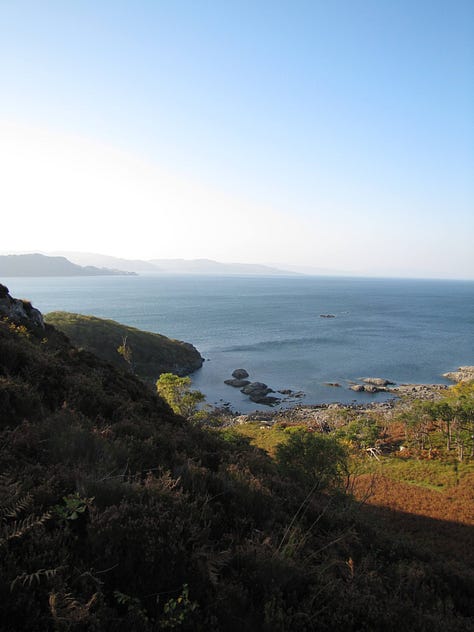
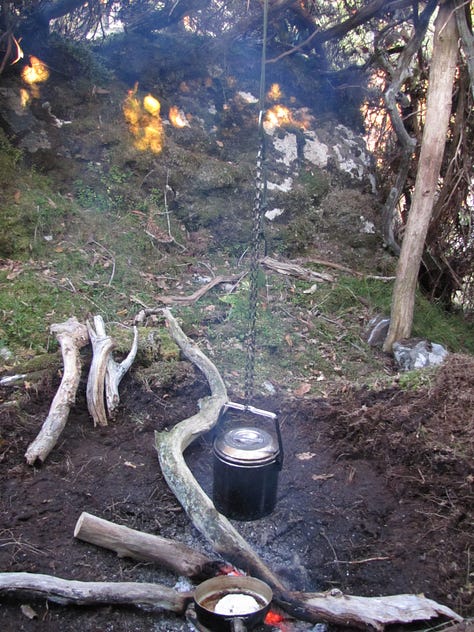
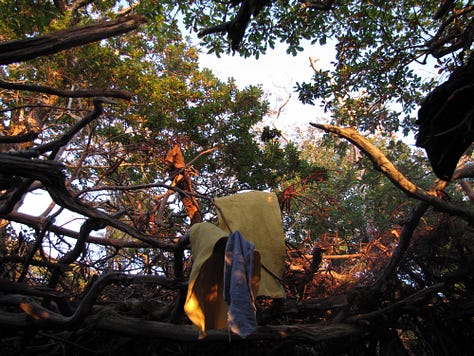

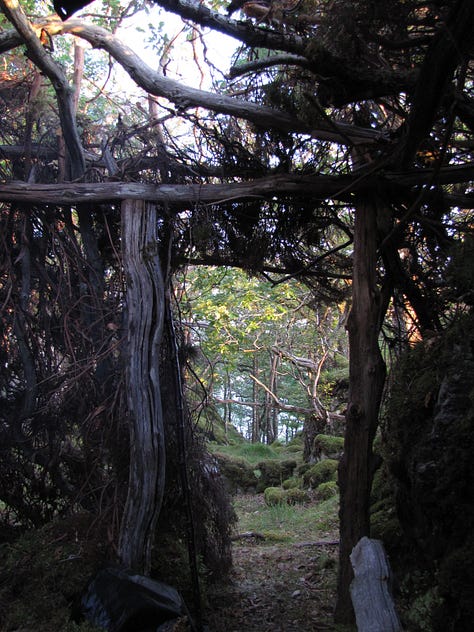
The Cacophony of Humankind
For the first time since leaving the city, over three weeks ago, I set an alarm for the morning of the 11th of October, 2010 and, of course, as ever, I woke before it. The train I hoped to catch to Fort William was not very early, but I thought it wise to factor in extra time for fire lighting, breakfast cooking, and the walk to the station—something I had yet to do from my new location.
The night was full of noise: the deer challenging and clashing, the Thing in the bracken behind my camp, and a female tawny owl calling over and over from downslope, her yip yip, yip, kee-wick, loud and incessant.
On the walk to the railway station, I followed a deer trail down the hill to the sea, then back up the path along the glen. I knew this route, and I had still not discovered my campsite had a backdoor of sorts. I took a lot of photos, of the dawn, of the walk, a few on the journey (it is really not possible to take photos through the window of a grubby train!), some in Fort William, and then some of the evening after I returned to my camp.
As I began my walk I found a patch of flattened grass and bracken, with massive slot marks in the soft ground, exactly where I had heard the noise. A solitary stag, bedding down for a break in the rut, gone before first light. He must have known I was there, but was either too exhausted or too full of testosterone to care.
I saw many other tracks, the valley bottom churned in places by the deer then, most excitingly, a single large cat print, substantially larger than the average domestic cat. I knew this area was known to have wild cats, the famous Highland tiger, untamed and untameable, and I was delighted to find this print—whilst simultaneously mildly irritated I could not at least attempt to follow it. In some ways, this was probably a good thing—tracking a wildcat is probably still beyond my skill level—back then, it was simply wishful thinking (yet this is, of course, how we learn, how we improve—we have to try and we have to fail, then fail better).
The weather was beautiful, with clear and sharply rich blue skies and a warm sun, yet that sun was beginning to get sleepier and a little more lazy each day, readying herself for a winter doze. Dawn was arriving progressively later each morning and the sun would set a little to the left every night, further and further southwards. The angles of shadows increased and, in the places where the sun no longer fell, chill gathered, like the air that clings inside caves or crypts. I was glad to be warmly dressed and I was glad I would soon be moving into my shelter.
My resupply was successful. I was three pennies short of the price of a return ticket and, in those days, paying by card was not possible. As it was, instead of having to buy a single, then another when I headed back, the cost almost double that of a return, the conductor let me off those three pennies, a simple kindness which stuck with me. I felt oddly emotional about this, even though it was such a small thing.
Parts of that rail journey might be recognisable to fans of the Harry Potter movies, seeing as it is where the titular hero and friends travel on their way to Hogwarts. It is stunning, yet also a little melancholy—those glens should each have villages, yet those people were cleared and sent away, whether to Glasgow, Australia, or Canada.
Packed and moved, against their wishes, to make way for sheep by the richer lairds—a topic I will no doubt return to.
Fort William was loud, it smelled of traffic and plastics, a cacophony of cars and voices constant and unsettling. Yet just a few weeks earlier, when I changed trains there, it felt like a large village to me. Perspectives change with time and experience, and time spent in the woods changes you in ways you might not always find comfortable.
My pack is huge, an 80 litre Karrimor SF rucksack which can be expanded to 130, with additional side pockets, for a total of 150 litres. I filled it with things, buying considerable quantities of staples, food to last me through weeks and weeks. I had no idea how long I would be out there—I still wanted to be in Caithness for Christmas, and I was making sure I had enough food to last me until this point, with one extra big Fort William resupply factored in before the clock change to ensure that my meals would not be bland and boring.
The sunset that evening was beautiful, with stunning colours reflected in the calm waters of the sea loch. As I stood, leaning against an oak, listening to the sounds of the evening chorus of birds and the deer roaring across the glen, I felt a sense of belonging, of deep calm, glad to be back in my small corner of woodland and hill, away from the hustle and bustle of others.
I had lived for nearly ten years in a city, prior to leaving for those hills, lochs, and woods—and yet I found coping with the sudden noise, garish sights, and horrendous scent of a comparatively small town difficult after nearly four weeks in the wilder places.
I was exhausted after carrying the weight of my supplies home, and packing and hanging the food to keep it away from the mice was an extra challenge. As I did so, I heard something moving right outside my shelter door, then a quick warning bark—not that of the deer, but a red fox, come to say hello and perhaps wonder what it could smell.
I ate well that night, frying some steak in butter and eating it wrapped in a fresh baguette, the butter drizzled over the whole. I had washed an empty glass peanut butter jar and used that to enjoy some red wine, listening to the tawny owls calling one another, sending shivers into the hearts of the local rodent population and joy into mine.
The fire was deliciously mesmeric, the flames dancing, the heat soothing, the soft crackle of seasoned oak calming. I was tempted to move into the shelter there and then, but decided to wait a wee bit longer, until I could sort out a comfortable bed.
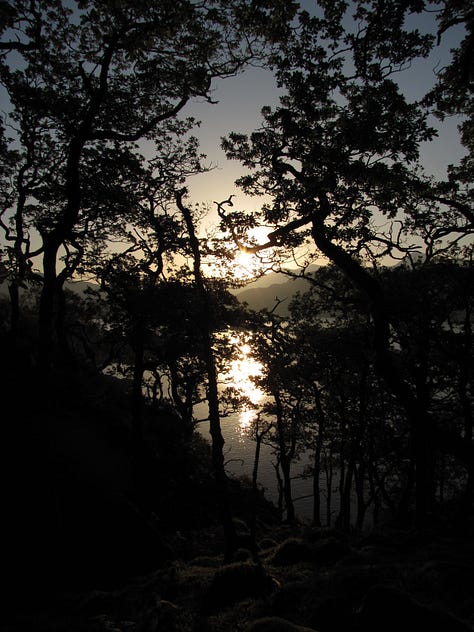
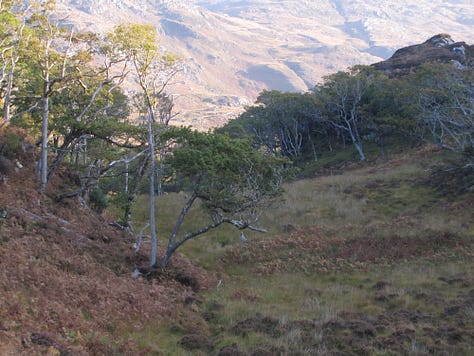
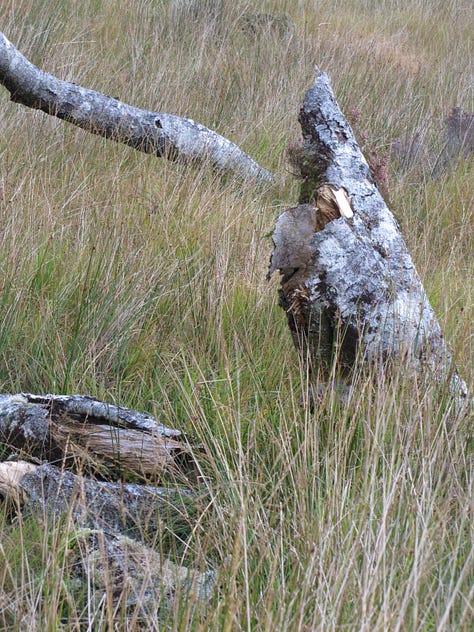
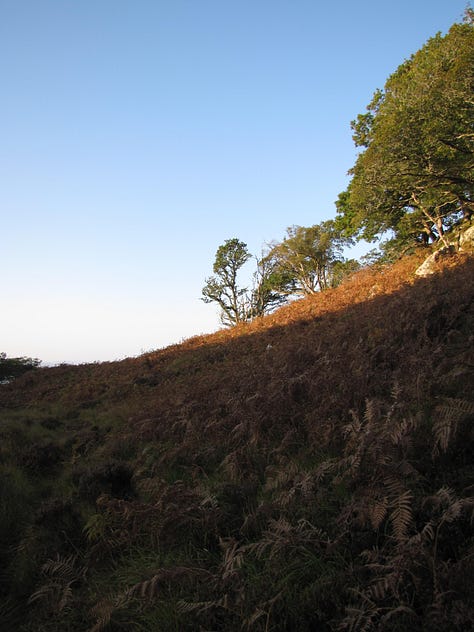
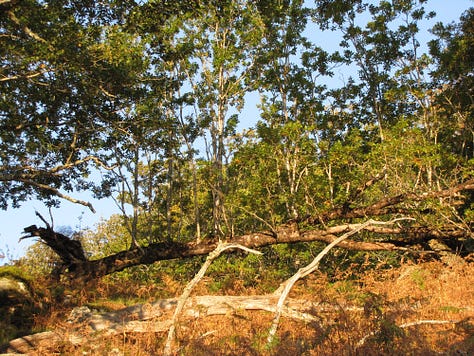
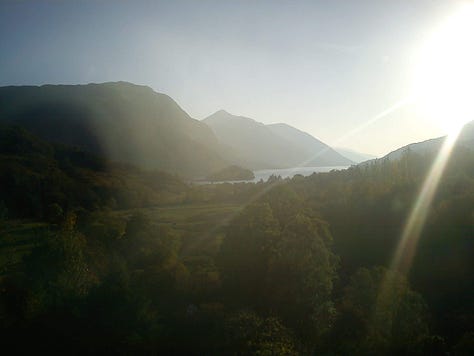
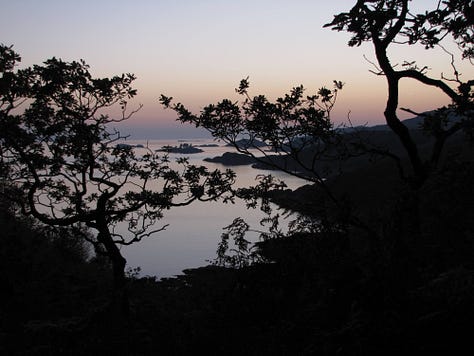
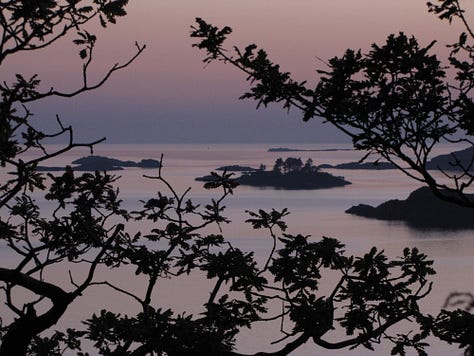
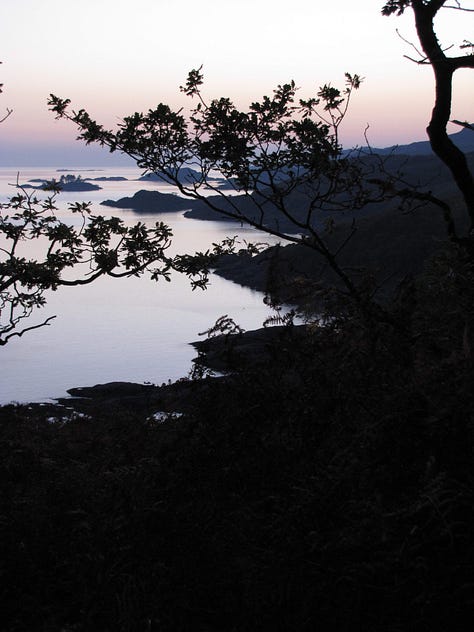
What About You?
Have you ever felt that dislocation, of visiting a place which shouldn’t feel busy and overwhelming, but does? (I do wonder if this feeling extended to a lot of the world following Covid and the lockdowns?) Do you love to comb beaches too (something I have previously shared further thoughts on here), have you ever found any Loki’s candles, and what is the strangest thing you have found? Or do you collect other items on your walks, perhaps stones, acorns, or seeds?
Finally
To read the introduction to my autumnal 2010 adventure, click here.
To go back to Week Three, click here.
I hope you are enjoying reading this revisited journey as much as I enjoy sharing it. If you have liked it, please share with anyone else you think may enjoy the adventure.
I truly appreciate every share, like, and comment. I will reply to everyone who leaves a message—sometimes it just takes a little longer than others.
Finally, if you find value in reading or listening to my words and wish to support me financially, but do not want to take out a subscription to my letter, you can also send a one-off tip via this button (and a huge thank you to those of you who have done so, I greatly appreciate that):
Thanks for reading,
Alex





